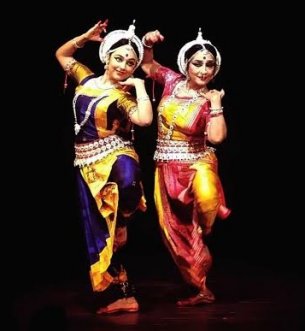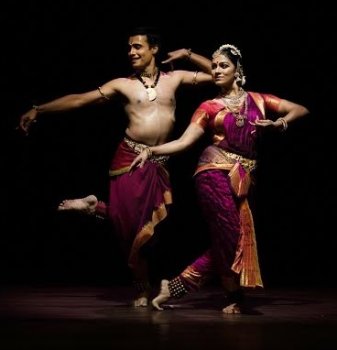
|   |

|   |
Samarasa featured delightful duet performances Text & pics: Akila Venkat e-mail: akilzasarch@gmail.com June 6, 2016 Bengaluru art lovers were treated to a delightful array of beautiful dance performances as Nrityantar presented Samarasa – a 2 day dance festival featuring thematic duets at Seva Sadan Auditorium. Odissi dancer Madhulita Mohapatra has been engaged in promotion and propagation of Odissi dance in the state through her institution Nrityantar that organizes regular and special dance classes for children as well as elders at several places in the city. It has been working with many schools in the city with the idea of including classical dance as an integral part of the curriculum and routine schooling. It organizes workshops, seminars, lecture demonstrations, dance programs and performances and its flagship Odissi dance festival Naman is a popular dance event. Samarasa celebrated the beauty of partnership. Partnering has been and still is very common in our classical dance performances on stage. A duet is not about two dancers dancing solo side by side but about the shared space of the two and coming together to express the choreographic intent. However, duet choreographies is a challenge it its own rule. An effective dance partnership requires teamwork, involvement and coordination, besides thorough understanding of the idiom. Varying physical strengths of two different bodies and emotional prowess of two minds come in perfect synergy along with harmonious interplay of motion and emotions when dancers dance in precise unison. Samarasa meaning ‘equal feelings’ and ‘even essence’ as the name suggests, truly celebrated the equipoise harmony, perfect balance and undifferentiated union of two dancers. Well known Bharatanatyam and Odissi dancers, established soloists in their own right, came together to present well-conceived duet choreographies on traditional subjects of mythology and spirituality, while exploring themes of universal human experiences of love and longing, passion and pain, joy and despair and the ultimate salvation in surrendering to the divine.  Vrinda Chadha & Ranjana Gauhar On May 7th, the festival opened with presentation titled Pratibimb by Guru Ranjana Gauhar and her disciple Vrinda Chadha. A dancer par excellence and a perfectionist to the core, Ranjana Gauhar along with her shishya, began their recital with Manikya Veena - an invocation to Goddess Saraswati, set to raga Bhopali and tala jati. It was followed by a dance piece titled ‘Dancing Footsteps in Rain’ based on Meera bhajan “Jhuki aayi badariya” set to raga Megh and tala jati. The item depicted Meera enjoying the rainy weather and mistaking the dark clouds for Krishna. Replete with emotions associated with rain – the childlike joy, the sensuous mood and the feeling of ecstasy, the part where she tried to embrace the clouds thinking it is Krishna and soon realizing her folly did tickle the audiences. The Pallavi set to raga Misra Shankarabaranam performed by Vrinda Chadha was delightful with visually pleasing postures and adept footwork. Ranjana Gauhar concluded with a beautifully presented shringara based abhinaya piece on the popular ashtapadi “Sakhi he” set to raga Pahadi.  Praveen Kumar & Soundarya Srivathsa The second half of the evening witnessed a Bharatanatyam duet presentation titled 'Shringara Lahari'. P Praveen Kumar, one of the best male exponents of Bharatanatyam today, came together with the equally talented Dr. Soundarya Srivathsa, a well-loved soloist in Bengaluru, who is admired and applauded for her impeccable footwork, consummate abhinaya and absorbing stage presence. Supported by live orchestra, the duo explored the shringara rasa in vastness and depth. Conceptualised and choreographed by them, they performed on a string of songs – “Radha Sametha Krishna”, “Rusali Radha”, “Yahi Madhava” and “Kshanam Adhuna Narayanam” in ragas Vasanth, Yaman Kalyani, Dwijawanti and Valachi. Based on seamlessly interwoven kritis, javalis and ashtapadis, the talented duo offered the audience a visual feast. Day 2 began with the Odissi duo, Madhulita Mohapatra and Bishwabhushan Mohapatra as they presented their thematic offering titled ‘Ekam ….. return to oneness’. The young talented duo brought on stage the fluid grace and lyrical beauty of Odissi dance, as they explored pining and merging of the individual soul, the human (jivatma) with the original source, the supreme soul, the God (paramatma), as propounded by the popular Advaita philosophy of monism. They commenced their recital with an invocation to Ardhanareeswara, representing the divine merging of the half-father, Shiva - the supreme consciousness and half-mother, Parvati/Shakti - the divine energy. Based on the popular Ardhanareeswara Stotram written by Adi Shankaracharya, its music was set to Ragamalika and Talamalika and composed by Pt. Raghunath Panigrahi. The item was beautifully choreographed and managed to mesmerise the audience. Their second item Varsha Avisar, was originally choreographed as a solo by Guru Aruna Mohanty. The dance piece celebrates the arrival of the first rain after the prolonged heat of summer. The dancers vividly expressed the glory of monsoon and rains and the significance of water in every manifestation of life and its existence.  Bishwabhushan Mohapatra & Madhulita Mohapatra “Chandana Charchita” based on the popular ashtapadi from Jayadeva’s Geeta Govinda had the captivated attention of the audience. The item described the beauty of Lord Krishna and his amorous pastimes with beautiful gopis of Vrindavan. Interspersed dance passages on rhythmic syllables were presented well with raasleela sequences. Madhulita’s powerful abhinaya skills shone through in her solo item “Harirabhisarati” based on the ashtapadi “Madhave Makuru”. The sakhi urges Radha to shed her pride towards Krishna and approach him. In the sequence, “harim avalokaya saphalaya nayane,” where the sakhi watches Krishna lying on the bed of lotus petals as she gets the true realisation of the Lord in his dashavatara forms and feels the intensity upon seeing him, Madhulita moved the audiences by her effortless yet spellbinding abhinaya. The Odissi duo concluded their recital with another ashtapadi “Radha Vadana.” After the prolonged separation, Radha and Krishna are united. The item depicted the merging of the mortal soul (jivatma) with the supreme soul, the God (paramatma), thereby doing justice to the theme Eka.  Seshadri Iyengar & Anuradha Vikranth The evening concluded with ‘Udvaha’ by Bharatanatyam dancers Seshadri Iyengar and Anuradha Vikranth. As the title Udvaha (marriage) suggests, the duo explored the ups and downs in the union of marriage. The presentation was conceptualised and choreographed by the duo within the traditional framework of classical Bharatanatyam. They began with pushpanjali set to Ragamalika and tala adi. It was followed by their main piece composed by Shatavadhani R Ganesh in Ragamalika and adi tala. The dancers took the audience through the turbulent journey that is marriage. It touched the highs and lows and the myriad of emotions that a couple go through. It was thoroughly enjoyed and applauded by all. Their concluding piece, a thillana in Sumanesha Ranjana raga and adi tala, provided a beautiful finish to their impressive rendition. On both days, it was heartening to witness a fully packed and overflowing hall. Prof. Mysore V Subramanya, Bharatanatyam Guru B. Bhanumathi, Dr. R.V. Raghavendra of Ananya, Kuchipudi Guru Veena Murthy Vijay, Bharatanatyam Guru Minal Prabhu, and writer Shyamhari Chakra, graced the festival with their distinguished presence. Akila Venkat is a classical arts enthusiast, who has learnt Bharatanatyam, Odissi and Carnatic music. She is a practicing freelance architect and a photographer. |